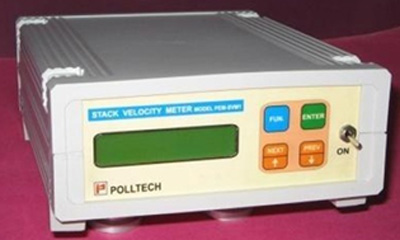Digital Stack Velocity Meter
Measuring stack velocity made easy.
A simple-to-use instrument which enables measurement of velocity in stacks and ducts in industrial plants by implementing methods recommended by US EPA and Indian BIS.
Available Model : PEM - SVM1

PEM–SVM1 is an electronic instrument enables measurement of three stack gas parameters viz. differential pressure created by it across a Pitot tube inserted in its path, its gauge pressure and its temperature. It programmatically computes the velocity at the point of location from the measured parameters and from the entered parameters of molecular weight / gas composition and Pitot calibration constant.
When measurements at multiple traverse points are taken, it automatically computes the average velocity and volumetric discharge of gas. It also implements user programmed strategy averaging for fluctuating velocities and computes number of traverse points and their distances from the user entered values of dimensions of stack / duct.
Applications:
- Used in conjunction with manual stack monitoring kits for ease of process and direct display.
- Can be used in duct measurements for volumetric discharge for measuring gas consumption.
- Velocity Distribution Studies by duct designers and manufacturers.
- Optimizing HVAC system performance.
Physical Design Highlights
It comprises a control module and the sensors for measuring Pitot differential pressure, stack gas gauge pressure and stack gas temperature. Pressure measurements are carried out solid state transducers. Temperature is measured by a K type thermocouple.
The control module houses the solid state transducers and all the electronics required for interfacing with these transducers and the thermocouple. The elegant cabinet of the control module is made of ABS plastic.
Salient Features :
- Microprocessor based electronics
- Digital display of various parameters
- Fast, reliable and accurate measurements
- Battery powered operation
- Compact, light weight, portable construction
Technical Specifications :
| Velocity Range | 2-100 m/s |
| Measured Parameters | Pitot DP, Stack Gas Gauge pressure and Temperature |
| Pitot DP Range | 200. 0 mm WC |
| Stack Gas Gauge pressure Range | 400. 0 mm WC |
| Stack Gas Temperature Range | 0 To 1200 °C with an accuracy of ± 2 °C |
| Display | 32 Character Alphanumeric LCD |
| Computed Parameters | Time- averaged Linear Velocity for each Traverse point, Average velocity, Volumetric Discharge |
| Communication port | RS-232 for data transfer to PC PC interface software provided on a CD |
| Transferred Data Type | All measured parameters, all computed parameters, all user supplied data |
| Housing | High quality, high quality ABS plastic, 21(L) x 16(W) x 6(H) cm |
| Power | 6V battery (4x1.5V Type AA cells), Adaptor (optional) |
| Size | 70(H) cm x 160(W) x 210(L) |
| Weight | 1 kg |
| Standard Accessories | 2 Nos. PU tube 3 meter long for connecting the Pitot tube and control Module 1 No. K type thermocouple 1 meter long with 3 meter cable for stack gas temperature up to 600°C |
| Optional Accessories | Pitot tube of different lengths |
Accuracy Specifications
| Pitot ∆p Pressure Accuracy | ± 0.5% of Full Scale |
| Stack Gas Gauge Pressure Accuracy | ± 1% of Full Scale |
| Gas Temperature Accuracy | ± 2°C |
Operating Environment
| Power | 6V battery (4x1.5 V Type AA cells), Adaptor (optional) |
| Temperature | 5 to 50 oC |
| Relative Humidity | Up to 95% non condensing |
Accessories
- Pitot tube of various lengths
- Thermocouple K type of various length
- Thermocouple extension cable
- PU tube with different lengths
Related Services
- Pressure Calibration
- Temperature Calibration
- Temperature Simulation for Thermocouples
Related Products :
- Automatic Stack Monitoring System Model PEM–SMS4
- Manual Stack Monitoring Kit Model PEM–SMK10B & 10M
- Heated Filter Box Model PEM–HFB2
- Heated Sampling Probes Model PEM-HGLP3, PEM-HTLP3, PEM–HSLP3
- PM10 Sampling Equipment Model PEM - STPM10-X
- PM2.5 Sampling Equipment Model PEM - STPM2.5-X
- Sampling Equipment for NOx, Sulfuric Acid Mist, Metal Emission, Halogen & Halides, Volatile Organic Compounds, Dioxins & Furans etc.

